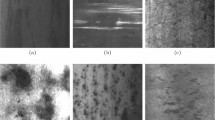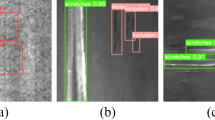Abstract
Deep learning algorithms have gained widespread usage in defect detection systems. However, existing methods are not satisfied for large-scale applications on surface defect detection of strip steel. In this paper, we propose a precise and efficient detection model, named CABF-YOLO, based on the YOLOX for strip steel surface defects. Firstly, we introduce the Triplet Convolutional Coordinate Attention (TCCA) module in the backbone of the YOLOX. By factorizing the pooling operation, the TCCA module can accurately capture cross-channel features to identify the location information of defects. Secondly, we design a novel Bidirectional Fusion (BF) strategy in the neck of the YOLOX. The BF strategy enhances the fusion of low-level and high-level semantic information to obtain fine-grained information. Lastly, the original bounding box loss function is replaced by the EIoU loss function. In the EIoU loss function, the penalty term is redefined to consider the overlap area, central point, and side length of the required regressions to accelerate the convergence rate and localization accuracy. On the benchmark NEU-DET dataset and GC10-DET dataset, the experimental results show that the CABF-YOLO achieves superior performance compared with other comparison models and satisfies the real-time detection requirement of industrial production.








Similar content being viewed by others
Data availability
The NEU-DET dataset analysed in the current study is openly available in the UCI repository at http://faculty.neu.edu.cn/songkechen/zh_CN/zdylm/263270/list/index.html. The GC10-DET dataset analysed in the current study is available in the GitHub repository at https://github.com/lvxiaoming2019/GC10-DET-Metallic-Surface-Defect-Datasets.git.
References
Yu J, Cheng X, Li Q (2022) Surface defect detection of steel strips based on anchor-free network with channel attention and bidirectional feature fusion. IEEE Trans Instrum Meas 71:1–10
Luo Q, Fang X, Sun Y, Liu L, Ai J, Yang C, Simpson O (2019) Surface defect classification for hot-rolled steel strips by selectively dominant local binary patterns. IEEE Access 7:23488–23499
Hou Z, Parker JM (2005) Texture defect detection using support vector machines with adaptive Gabor wavelet features. In: 2005 Seventh IEEE Workshops on Applications of Computer Vision (WACV/MOTION’05), vol 1, pp 275–280
Ghorai S, Mukherjee A, Gangadaran M, Dutta PK (2012) Automatic defect detection on hot-rolled flat steel products. IEEE Trans Instrum Meas 62(3):612–621
Xu K, Ai Y-H, Wu X-Y (2013) Application of multi-scale feature extraction to surface defect classification of hot-rolled steels. Int J Miner Metall Mater 20:37–41
Pernkopf F (2004) Detection of surface defects on raw steel blocks using Bayesian network classifiers. Pattern Anal Appl 7:333–342
Xue-Wu Z, Yan-Qiong D, Yan-Yun L, Ai-Ye S, Rui-Yu L (2011) A vision inspection system for the surface defects of strongly reflected metal based on multi-class SVM. Expert Syst Appl 38(5):5930–5939
Girshick R, Donahue J, Darrell T, Malik J (2014) Rich feature hierarchies for accurate object detection and semantic segmentation. In: Proceedings of the IEEE conference on computer vision and pattern recognition, pp 580–587
Girshick R (2015) Fast R-CNN. In: Proceedings of the IEEE international conference on computer vision, pp 1440–1448
Ren S, He K, Girshick R, Sun J, Faster R-CNN: towards real-time object detection with region proposal networks. Adv Neural Inf Processing Syst 28
Redmon J, Divvala S, Girshick R, Farhadi A (2016) You only look once: unified, real-time object detection. In: Proceedings of the IEEE conference on computer vision and pattern recognition, pp 779–788
Redmon J, Farhadi A (2017) YOLO9000: better, faster, stronger. In: Proceedings of the IEEE conference on computer vision and pattern recognition, pp 7263–7271
Lin T-Y, Goyal P, Girshick R, He K, Dollár P (2017) Focal loss for dense object detection. In: Proceedings of the IEEE international conference on computer vision, pp 2980–2988
Lin T-Y, Dollár P, Girshick R, He K, Hariharan B, Belongie S (2017) Feature pyramid networks for object detection. In: Proceedings of the IEEE conference on computer vision and pattern recognition, pp 2117–2125
Redmon J, Farhadi A (2018) YOLOv3: an incremental improvement. arXiv:1804.02767
Alexey B, Wang C, Mark Liao H (2020) Optimal speed and accuracy of object detection. arXiv:2004.10934
Jocher G (2021) YOLOv5 by ultralytics. https://doi.org/10.5281/zenodo.3908559
Ge Z, Liu S, Wang F, Li Z, Sun J (2021) YOLOX: exceeding YOLO series in 2021. arXiv:2107.08430
Li C, Li L, Jiang H, Weng K, Geng Y, Li L, Ke Z, Li Q, Cheng M, Nie W et al (2022) Yolov6: a single-stage object detection framework for industrial applications. arXiv:2209.02976
Ding X, Zhang X, Ma N, Han J, Ding G, Sun J (2021) RepVGG: making VGG-style convnets great again. In: Proceedings of the IEEE/CVF conference on computer vision and pattern recognition, pp 13733–13742
Wang C-Y, Bochkovskiy A, Liao H-YM (2023) Yolov7: trainable bag-of-freebies sets new state-of-the-art for real-time object detectors. In: Proceedings of the IEEE/CVF conference on computer vision and pattern recognition, pp 7464–7475
Jocher G, Chaurasia A, Qiu J (2023) YOLO by Ultralytics. https://github.com/ultralytics/ultralytics
He Y, Song K, Meng Q, Yan Y (2019) An end-to-end steel surface defect detection approach via fusing multiple hierarchical features. IEEE Trans Instrum Meas 69(4):1493–1504
Lv X, Duan F, Jiang J-J, Fu X, Gan L (2020) Deep metallic surface defect detection: the new benchmark and detection network. Sensors 20(6):1562
Kou X, Liu S, Cheng K, Qian Y (2021) Development of a YOLO-V3-based model for detecting defects on steel strip surface. Measurement 182:109454
Zhao W, Chen F, Huang H, Li D, Cheng W (2021) A new steel defect detection algorithm based on deep learning. Comput Intell Neurosci 2021:1–13
Tian R, Jia M (2022) DCC-CenterNet: a rapid detection method for steel surface defects. Measurement 187:110211
Yu X, Lyu W, Zhou D, Wang C, Xu W (2022) ES-Net: Efficient scale-aware network for tiny defect detection. IEEE Trans Instrum Meas 71:1–14
Wang W, Mi C, Wu Z, Lu K, Long H, Pan B, Li D, Zhang J, Chen P, Wang B (2022) A real-time steel surface defect detection approach with high accuracy. IEEE Trans Instrum Meas 71:1–10
Guo Z, Wang C, Yang G, Huang Z, Li G (2022) MSFT-YOLO: improved YOLOv5 based on transformer for detecting defects of steel surface. Sensors 22(9):3467
Wang Y, Wang H, Xin Z (2022) Efficient detection model of steel strip surface defects based on YOLO-V7. IEEE Access 10:133936–133944
Zhou X, Wei M, Li Q, Fu Y, Gan Y, Liu H, Ruan J, Liang J (2023) Surface defect detection of steel strip with double pyramid network. Appl Sci 13(2):1054
Liu R, Huang M, Gao Z, Cao Z, Cao P (2023) MSC-DNet: an efficient detector with multi-scale context for defect detection on strip steel surface. Measurement 209:112467
Chen H, Du Y, Fu Y, Zhu J, Zeng H (2023) DCAM-Net: a rapid detection network for strip steel surface defects based on deformable convolution and attention mechanism. IEEE Trans Instrum Meas 72:1–12
Zhang Y, Zhang H, Huang Q, Han Y, Zhao M (2024) DsP-YOLO: an anchor-free network with DsPAN for small object detection of multiscale defects. Expert Syst Appl 241:122669
Zhang Y-F, Ren W, Zhang Z, Jia Z, Wang L, Tan T (2022) Focal and efficient IOU loss for accurate bounding box regression. Neurocomputing 506:146–157
Song K, Yan Y (2013) A noise robust method based on completed local binary patterns for hot-rolled steel strip surface defects. Appl Surf Sci 285:858–864
Hou Q, Zhou D, Feng J (2021) Coordinate attention for efficient mobile network design. In: Proceedings of the IEEE/CVF conference on computer vision and pattern recognition, pp 13713–13722
Li D, Hu J, Wang C, Li X, She Q, Zhu L, Zhang T, Chen Q (2021) Involution: inverting the inherence of convolution for visual recognition. In: Proceedings of the IEEE/CVF conference on computer vision and pattern recognition, pp 12321–12330
Sunkara R, Luo T (2022) No more strided convolutions or pooling: a new CNN building block for low-resolution images and small objects. arXiv:2208.03641
Hu J, Shen L, Sun G (2018) Squeeze-and-excitation networks. In: Proceedings of the IEEE conference on computer vision and pattern recognition, pp 7132–7141
Woo S, Park J, Lee J-Y, Kweon IS (2018) CBAM: convolutional block attention module. In: Proceedings of the European conference on computer vision (ECCV), pp 3–19
Wang Q, Wu B, Zhu P, Li P, Zuo W, Hu Q (2020) ECA-net: efficient channel attention for deep convolutional neural networks. In: Proceedings of the IEEE/CVF conference on computer vision and pattern recognition, pp 11534–11542
Funding
The authors declare that they have not received funding from any organization with respect to the submitted work.
Author information
Authors and Affiliations
Contributions
Author Qiqi Zhou designed the model and executed experiments, analyzed the performance results of the model, and prepared the original manuscript draft. Author Haichao Wang provided essential theoretical insights and critically revised the manuscript for important intellectual content. All authors read and approved the final manuscript prior to submission
Corresponding author
Ethics declarations
Conflict of interest
The authors declare no Conflict of interest.
Ethical Approval
This declaration is not applicable.
Additional information
Publisher's Note
Springer Nature remains neutral with regard to jurisdictional claims in published maps and institutional affiliations.
Rights and permissions
Springer Nature or its licensor (e.g. a society or other partner) holds exclusive rights to this article under a publishing agreement with the author(s) or other rightsholder(s); author self-archiving of the accepted manuscript version of this article is solely governed by the terms of such publishing agreement and applicable law.
About this article
Cite this article
Zhou, Q., Wang, H. CABF-YOLO: a precise and efficient deep learning method for defect detection on strip steel surface. Pattern Anal Applic 27, 36 (2024). https://doi.org/10.1007/s10044-024-01252-5
Received:
Accepted:
Published:
DOI: https://doi.org/10.1007/s10044-024-01252-5




